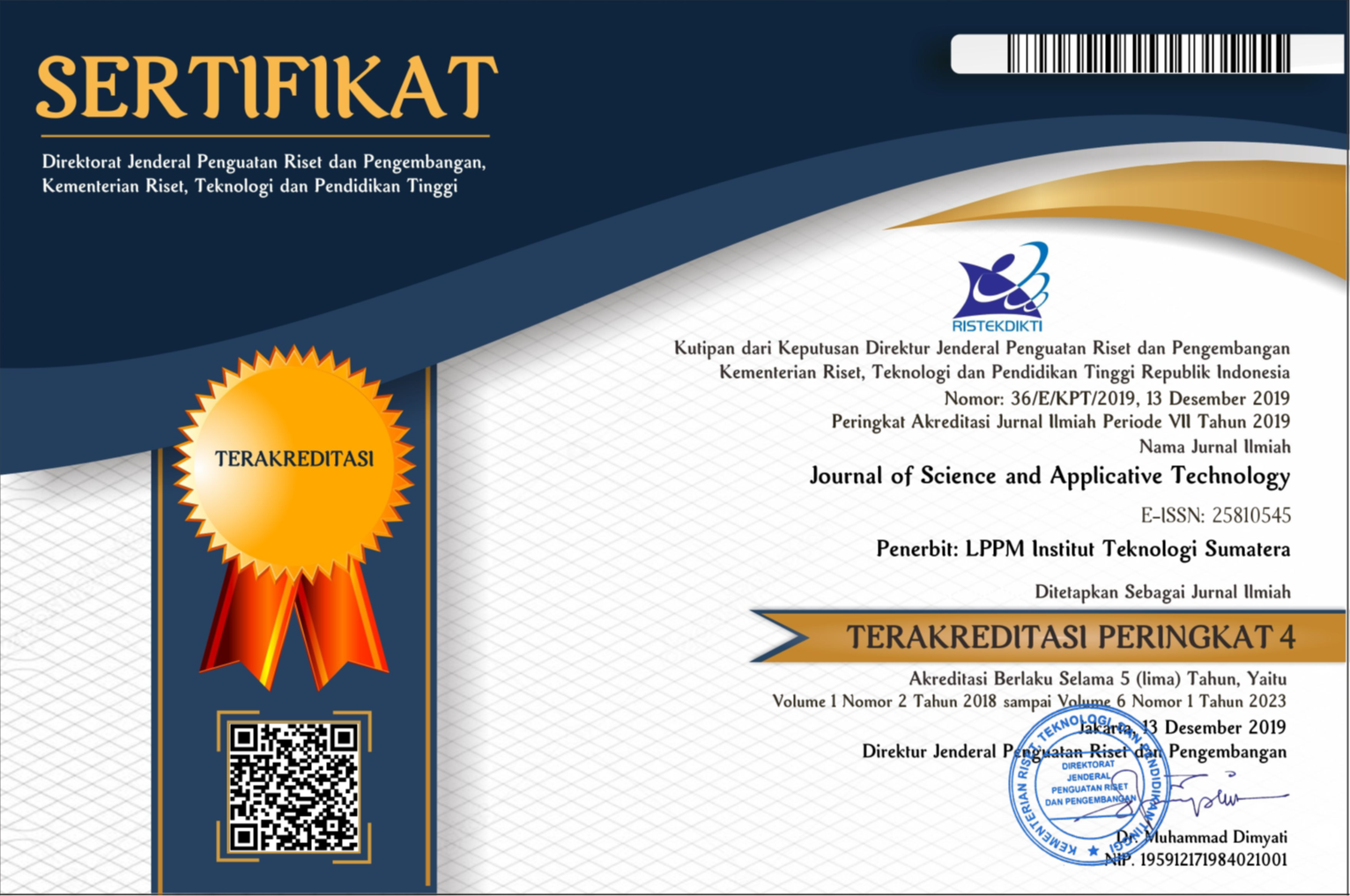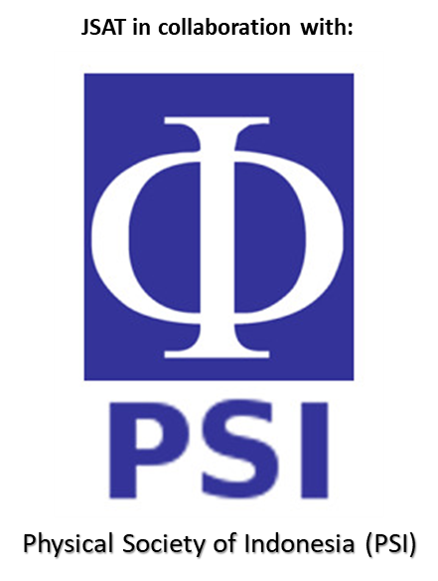FORMULASI NANOEKAPSULASI EKSTRAK DAUN KELOR (Moringa oleifera) /KITOSAN-NATRIUM TRIPOLIPOSFAT (NaTPP)
Abstract
Moringa (Moringa oliefera) contains several antioxidant compounds such as quercetin and chlorogenic acid. However, antioxidants have weaknesses, namely that they are easily damaged by exposure to oxygen, light, high temperatures, and drying. One way to maintain and increase the stability of antioxidants is by encapsulation. The purpose of this study was to determine the optimum formulation of quercetin nanoencapsulation of moringa leaf extract using chitosan and sodium tripolyphosphate (Na-TPP) using the ultrasonication method. Moringa leaf extract was obtained by repeated ultrasonication 1x 15, 3x15, and 5x15 minutes, frequency 24 kHz, and using alcohol 96%. The encapsulation process was carried out with three variable ratios of the amount of chitosan: Na-TPP added to 10 mL of Moringa leaf extract solution (F0), namely 5:1 (F1), 2:1 (F2), and 1:1 (F3). Test results for flavonoids as quercetin using a UV-Vis spectrophotometer showed that the Quercetin content in Moringa leaf extract ultrasonicated 5x15 minutes was 12.146%, the characterization of the Particle Size Analyzer (PSA) showed encapsulated particle sizes of 170.3 and 209.7 nm with polydisperse index <0 .5, the antioxidant activity test using the DPPH method showed that F0 was 61.4% and F2 had the highest antioxidant activity, namely 81.2%. Analysis of the morphology of nanoparticles using Scanning Electron Microscopy (SEM) showed that the particles were spherically distributed evenly. Nanoencapsulation of Moringa leaf extract has resulted and an increase in the antioxidant activity of Moringa leaf extract after encapsulation using Chitosan-NaTPP, from 61.4% to 81.2% (F2).
Downloads
References
[2] K. H. Rahayu, I., & Timotius, “The effects of predrying treatments and different drying methods on Phytochemical Analysis, Antimutagenic and Antiviral Activity of Moringa oleifera L. Leaf Infusion: In Vitro and In Silico Studies,” Molecules, vol. 27, no. 13, p. 4017, 2022.
[3] C. Suphachai, “Antioxidant and anticancer activities of Moringa oleifera leaves,” J. Med. Plants Res., vol. 8, no. 7, pp. 318–325, 2014.
[4] Suhartati T., “Isolasi Dan Karakterisasi Senyawa Flavonoid Dari Kulit Akar Tumbuhan Sukun Artocarpus Altilis (Parkinson) Fosberg,” J. Sci. Appl. Technol. Teknol. Sumatera, pp. 54–61, 2018.
[5] P. Hidayat, R., & Wulandari, “Methods of extraction: Maceration, percolation and decoction,” Eureka Herba Indones., vol. 2, no. 1, pp. 68–74, 2021.
[6] H. Hasriandi, “Optimasi Proses Ekstraksi Metabolit Sekunder dari Umbi Bawang Dayak (Eleutherine americana) secara Ultrasonic Assisted Extraction,” Universitas Hasanuddin, 2022.
[7] T. S. Yunira EN, Suryani A, Dadang D, “Identifikasi Karakteristik Pengecilan Ukuran dengan Metode Sonikasi dari Formula Insektisida yang Ditambahkan Surfaktan Berbasis Sawit,” J. Sci. Appl. Technol. Teknol. Sumatera, vol. 5, no. 1, pp. 85-91., 2021.
[8] F. Vernes, L., Abert-Vian, M., El Maâtaoui, M., Tao, Y., Bornard, I., & Chemat, “Application of ultrasound for green extraction of proteins from spirulina. Mechanism, optimization, modeling, and industrial prospects,” Ultrason. Sonochem., vol. 54, pp. 48-60., 2019.
[9] S. Umaña, M., Calahorro, M., Eim, V., Rosselló, C., & Simal, “Measurement of microstructural changes promoted by ultrasound application on plant materials with different porosity,” Ultrason. Sonochem., vol. 88, no. 106087, 2022.
[10] C. Bernardi, S., Lupatini-Menegotto, A. L., Kalschne, D. L., Moraes Flores, É. L., Bittencourt, P. R. S., Colla, E., & Canan, “Ultrasound: A suitable technology to improve the extraction and techno-functional properties of vegetable food proteins,” Plant Foods Hum. Nutr., vol. 76, no. 1, pp. 1–11, 2021.
[11] A. Rathore, R. S., & Dvivedi, “Sonication of tool electrode for utilizing high discharge energy during ECDM,” Mater. Manuf. Process., vol. 35, no. 4, pp. 415-429., 2021.
[12] W. DA Anggraini Y, “Deteksi Golongan Senyawa Ekstrak Kasar Metabolit Ekstrasel Mikroalga Laut Spirulina sp. Sebagai Agen Antioksidan,” J. Sci. Appl. Technol., vol. 5(1):202-7, no. 1, pp. 202–207, 2021.
[13] Z. Enaru, B., Drețcanu, G., Pop, T. D., Stǎnilǎ, A., & Diaconeasa, “Anthocyanins: Factors affecting their stability and degradation,” Antioxidants, vol. 10, no. 12, p. 1967, 2021.
[14] F. Gutiérrez-del-Río, I., López-Ibáñez, S., Magadán-Corpas, P., Fernández-Calleja, L., Pérez-Valero, Á., Tuñón-Granda, M., ... & Lombó, “Terpenoids and polyphenols as natural antioxidant agents in food preservation,” Antioxidants, vol. 10, no. 8, p. 1264., 2021.
[15] J. BRATOVCIC, A., & SULJAGIC, “Micro-and nano-encapsulation in food industry,” Croat. J. food Sci. Technol., vol. 11, no. 1, pp. 113–121, 2019.
[16] J. M. Pateiro, M., Gómez, B., Munekata, P. E., Barba, F. J., Putnik, P., Kovačević, D. B., & Lorenzo, “Nanoencapsulation of promising bioactive compounds to improve their absorption, stability, functionality and the appearance of the final food products,” Molecules, vol. 26, no. 6, p. 1547, 2021.
[17] S. Sidauruk, H., Munandar, A., & Haryati, “The production of nanoparticles chitosan from crustaceans shell using the top-down method.,” EDP Sci., vol. 147, p. 03025, 2020.
[18] E. T. Webber, M. J., & Pashuck, “(Macro) molecular self-assembly for hydrogel drug delivery,” Adv. Drug Deliv. Rev., vol. 172, pp. 275-295., 2021.
[19] A. El Knidri, H., Belaabed, R., Addaou, A., Laajeb, A., & Lahsini, “Extraction, chemical modification and characterization of chitin and chitosan,” Int. J. Biol. Macromol., vol. 120, pp. 1181–1189, 2018.
[20] H. T. Öztürk, A. A., & Kıyan, “Treatment of oxidative stress-induced pain and inflammation with dexketoprofen trometamol loaded different molecular weight chitosan nanoparticles: Formulation, characterization and anti-inflammatory activity by using in vivo HET-CAM assay,” Microvasc. Res., vol. 128, p. 103961, 2020.
[21] P. Mikušová, V., & Mikuš, “Advances in chitosan-based nanoparticles for drug delivery.,” Int. J. Mol. Sci., vol. 22, no. 17, p. 9652, 2021.
[22] S. Eivazzadeh-Keihan, R., Radinekiyan, F., Maleki, A., Bani, M. S., Hajizadeh, Z., & Asgharnasl, “A novel biocompatible core-shell magnetic nanocomposite based on cross-linked chitosan hydrogels for in vitro hyperthermia of cancer therapy,” Int. J. Biol. Macromol., vol. 140, pp. 407–414, 2019.
[23] N. Crini, G., Torri, G., Lichtfouse, E., Kyzas, G. Z., Wilson, L. D., & Morin-Crini, “Dye removal by biosorption using cross-linked chitosan-based hydrogels,” Environ. Chem. Lett., vol. 17, no. 4, pp. 1645–1666, 2019.
[24] M. R. Jawad, A. H., Abdulhameed, A. S., Kashi, E., Yaseen, Z. M., ALOthman, Z. A., & Khan, “Cross-linked chitosan-glyoxal/kaolin clay composite: parametric optimization for color removal and COD reduction of remazol brilliant blue R dye,” J. Polym. Environ., vol. 30, no. 1, pp. 164–178, 2022.
[25] S. Algharib, S. A., Dawood, A., Zhou, K., Chen, D., Li, C., Meng, K., ... & Xie, “Preparation of chitosan nanoparticles by ionotropic gelation technique: Effects of formulation parameters and in vitro characterization,” J. Mol. Struct., vol. 1252, p. 132129, 2022.
[26] A. Mohammadpour, H., Sadrameli, S. M., Eslami, F., & Asoodeh, “Optimization of ultrasound-assisted extraction of Moringa peregrina oil with response surface methodology and comparison with Soxhlet method,” Ind. Crops Prod., vol. 131, pp. 106–116, 2019.
[27] S. Qian, J., Zhao, F., Gao, J., Qu, L., He, Z., & Yi, “Characterization of the structural and dynamic changes of cell wall obtained by ultrasound-water and ultrasound-alkali treatments,” Ultrason. Sonochem., vol. 77, p. 105672, 2021.
[28] P. Hao, M. H., Zhang, F., Liu, X. X., Wang, L. J., Xu, S. J., Zhang, J. H., ... & Xu, “Qualitative and quantitative analysis of catechin and quercetin in flavonoids extracted from Rosa roxburghii Tratt,” Trop. J. Pharm. Res., vol. 17, no. 1, pp. 71–76, 2018.
[29] Z. Huang, G., He, J., Zhang, X., Feng, M., Tan, Y., Lv, C., ... & Jin, “Applications of Lambert-Beer law in the preparation and performance evaluation of graphene modified asphalt,” Constr. Build. Mater., vol. 273, p. 121582, 2021.
[30] S. Baba, W. N., Abdelrahman, R., & Maqsood, “Conjoint application of ultrasonication and redox pair mediated free radical method enhances the functional and bioactive properties of camel whey-quercetin conjugates,” Ultrason. Sonochem., vol. 79, p. 105784, 2021.
[31] W. Pham, D. T., & Tiyaboonchai, “Fibroin nanoparticles: A promising drug delivery system,” Drug Deliv., vol. 27, no. 1, pp. 431–448, 2020.
[32] B. S. Bhattacharyya, S., & Sogali, “Application of statistical design to assess the critical process parameters of ethanol injection method for the preparation of liposomes,” Dhaka Univ. J. Pharm. Sci., vol. 18, no. 1, pp. 103–111, 2019.
[33] H. Jiang, T., Ye, S., Liao, W., Wu, M., He, J., Mateus, N., & Oliveira, “The botanical profile, phytochemistry, biological activities and protected-delivery systems for purple sweet potato (Ipomoea batatas (L.) Lam.): An up-to-date review,” Food Res. Int., 2022.
[34] N. M. D. Arozal, W., Louisa, M., Rahmat, D., Chendrana, P., & Sandhiutami, “Development, characterization and pharmacokinetic profile of chitosan-sodium tripolyphosphate nanoparticles based drug delivery systems for curcumin,” Adv. Pharm. Bull., vol. 11, no. 1, p. 77, 2021.
[35] S. K. Khandel, P., Yadaw, R. K., Soni, D. K., Kanwar, L., & Shahi, “Biogenesis of metal nanoparticles and their pharmacological applications: present status and application prospects.,” J. Nanostructure Chem., vol. 8, no. 3, pp. 217–254, 2018.
Copyright (c) 2022 Journal of Science and Applicative Technology

This work is licensed under a Creative Commons Attribution-NonCommercial 4.0 International License.
All the content on Journal of Science and Applicative Technology (JSAT) may be used under the terms of the Creative Commons Attribution-NonCommercial 4.0 International License.
You are free to:
- Share - copy and redistribute the material in any medium or format
- Adapt - remix, transform, and build upon the material
Under the following terms:
- Attribution - You must give appropriate credit, provide a link to the license, and indicate if changes were made. You may do so in any reasonable manner, but not in any way that suggests the licensor endorses you or your use.
- NonCommercial - You may not use the material for commercial purposes.
- No additional restrictions - You may not apply legal terms or technological measures that legally restrict others from doing anything the license permits.





















